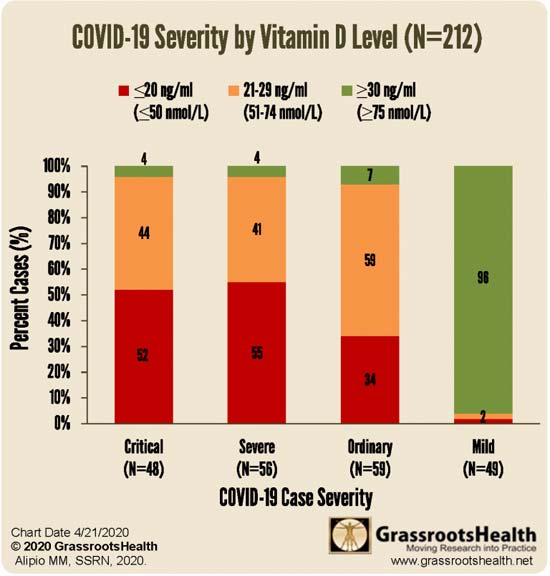Vitamin D Combats Viral Infections and Boosts Immune System
Story at-a-glance
- GrassrootsHealth recently conducted a review of an observational study involving 212 patients who had COVID-19, identifying a correlation between vitamin D levels and disease severity. Those with the mildest disease had the highest vitamin D levels, and vice versa
- A second study [ from Indonesia] found those with a vitamin D level between 20 ng/mL and 30 ng/mL had a sevenfold higher risk of death than those with a level above 30 ng/mL. Having a level below 20 ng/mL was associated with a 12 times higher risk of death, compared to having a level above 30 ng/mL
- The color of your skin has correlations to your vitamin D level, and we’re also seeing racial disparities in COVID-19. In Detroit, Michigan, where blacks account for 14% of the population, they account for 40% of COVID-19 deaths
- It’s important for people with darker skin to realize that the more melanin you have, the more sun exposure you require to make sufficient amounts of vitamin D, and many may need to take a supplement
- According to the research done by GrassrootsHealth’s panel of 48 vitamin D researchers, 40 ng/mL is the lower edge of optimal, with 60 ng/mL to 80 ng/mL being ideal for health and disease prevention
[…]
Vitamin D Levels Correlate With Disease Severity
GrassrootsHealth recently conducted a review of an observational study involving 212 patients in Southeast Asia who had COVID-19, identifying a correlation between vitamin D levels and disease severity. Those with the mildest disease had the highest vitamin D levels, and vice versa.
Of the 212 people, 49 had mild disease; 59 had ordinary disease; 56 were severe and 48 were critical. In the initial study group of 212 patients (see Table 1 below), 55 had normal vitamin D levels, which was defined as greater than 30 ng/ml; 80 had insufficient levels of 21 to 29 ng/ml and 77 had deficient levels of less than 20 ng/ml.
Now, it’s worth noting that the “optimal” vitamin D level in that study was set at 30 nanograms per milliliter (30 ng/mL), which may actually be suboptimal. According to the research done by GrassrootsHealth, 40 ng/mL is the lower edge of optimal, with 60 ng/mL to 80 ng/mL being ideal for health and disease prevention. Despite that, the benefit of having a vitamin D level above 30 ng/mL was clear.


[Specifically, study authors said: “For each standard deviation increase in vitamin D level, the odds of having a mild case compared to a severe case were 7.94 times more, and the odds of having a mild case compared to a critical case were 19.61 times more … This means that serum (OH)D levels in the body could account for the clinical outcomes of the patients infected with COVID-2019.”]
[REPORT: First Data to be Published on COVID-19 Severity and Vitamin D Levels]
Vitamin D Levels Correlate With Mortality Risk
A second study looked at the data from 780 hospital patients in Indonesia. The same vitamin D level cutoffs were used in this study: below 20 ng/mL; between 20 ng/mL and 30 ng/mL; and above 30 ng/mL.
After adjusting for confounding factors, those with a vitamin D level between 20 ng/mL and 30 ng/mL had a sevenfold higher risk of death than those with a level above 30 ng/mL. Having a level below 20 ng/mL was associated with a 12 times higher risk of death. As noted by Hollis, “That’s really strong data.”
[…]
Skin Color Impacts Your Vitamin D Deficiency Risk
The color of your skin has correlations to your vitamin D level, and we’re also seeing racial disparities in COVID-19. As noted by Hollis, in Detroit, Michigan, where African-Americans account for 14% of the population, they accounted for 40% of COVID-19 deaths.1
“It was even worse in Sweden where the Somali population is less than 1%, and they [account for] 40% of the deaths,” Hollis says. “In Britain, of the 24 health care physicians who have died, 23 were people of color. It was so bad that they pulled those people off the front lines … the physicians and the nurses.”
Vitamin D deficiency likely plays a role in this racial disparity, although nutrition, obesity and diabetes rates also contribute to immune dysfunction. It’s important for people with darker skin to realize that the more melanin you have, the more sun exposure you require to make sufficient amounts of vitamin D.
According to Hollis, it’s physiologically impossible for a dark-skinned individual in the United States, unless they’re in Southern Florida or Hawaii, to get optimal vitamin D from typical sun exposure.

Leave a Reply